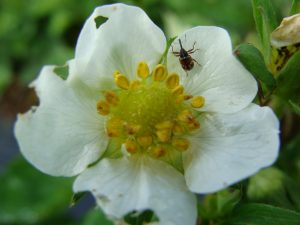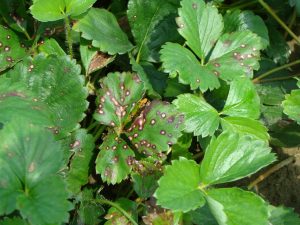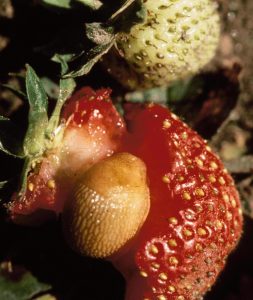Strawberry IPM Newsletter — May 24, 2024
STRAWBERRY BLOOM IN SOUTHERN MAINE
Insect Pest Counts Very Low; Bloom Sprays Should Target Gray
Situation: Early strawberry varieties are coming into full bloom in the southern part of the state. Overall, fields look very good, except where significant flooding occurred, or deer have been feeding. Insect pest numbers continue to be very low, and populations have not yet exceeded control thresholds for any problems except two-spotted spider mites. Growers seeing bloom beginning in their fields should be applying preventive fungicide sprays for gray mold.
Two Spotted Spider Mites: We have found mites in most fields we’ve scouted this week, but populations have been below control threshold with the exception of one southern field. Continue to scout for mites regularly, as populations can increase rapidly with warmer, drier weather. To scout for mites, collect 60 leaves from various locations in the field and examine the undersides for the presence of mites. Chemical control options for two-spotted spider mites include Acramite®, Portal®, Nealta® Savey®, Zeal®, Vendex®, Oberon®, Brigade®, Danitol®.

Strawberry bud weevil: We have not yet found any bud damage from “clippers”, but growers with fields coming into bloom should now be scouting for clipped buds in their fields. Small holes in the petals of opening flowers indicates clipper feeding. Clippers can often be found within the flower clusters, laying eggs and feeding on pollen. The control threshold for clipper injury is more than 1.2 clipped buds per two feet of row. Clipper damage will be most common in later blooming varieties this spring, given its late appearance. Insecticide options for clippers include Brigade®, Bifenture®, Danitol®, Sevin XLR Plus® and PyGanic®.
Tarnished plant bugs: No fields scouted this week were over threshold for tarnished plant bug. Nymphs are just beginning to appear, and numbers have been very low. However, it is important to scout for them regularly, as they may appear very quickly with drier weather. The threshold for plant bug nymphs is 4 or more flower clusters infested per 30 sampled. Tap flower clusters over a plate or tray to knock nymphs off. Insecticide options for tarnished plant bugs include malathion, Assail®, Brigade®, Bifenture®, Dibrom®, Danitol®, Closer® and PyGanic®.
Diseases: Early bloom fungicide sprays are recommended to protect strawberry fruit against gray mold, especially when conditions have been damp. Two to three sprays of fungicide during bloom are typically required to provide good protection. Most fruit infection takes place through the flowers, so control efforts should take place during the bloom period. Fungicide choices for control of gray mold in strawberries include: Topsin M® + captan, Elevate®, Captevate®, Switch®, Scala® and Pristine®. Remember to alternate fungicides with different modes of action for resistance management purposes.

Leather rot (Phytopthora cactorum) can become a problem in fields where standing water is common during bloom and fruit development, especially if the fields were not mulched last fall. Incidence of leather rot can be reduced by applying straw mulch between the rows to prevent berries from touching the soil and reducing soil splashing onto the berries. Foliar sprays of Aliette®, Prophyt® or Phostrol® may be applied during bloom and fruit development to prevent leather rot.
Leaf spot is a fungal disease characterized by small purple spots with white centers on the leaves. The symptoms are often first visible on the older, lower leaves. If you see leaf spot in your field, you should consider using a fungicide that will provide control as part of your spray program for gray mold. Products such as Captan®, Luna Sensation®, Mervion® and Pristine® have activity on both diseases.
Slugs may be a problem this season. Moist conditions and mulch encourage the presence of these mollusks. Slugs usually feed at night, leaving large holes in the leaves and tunnels in the ripening fruit. Baits such as Deadline® and Sluggo® offer some control, but should be used prior to fruit ripening. Pay close attention to label instructions and precautions. Baits should also be applied to the fields in mid-September if slugs have been a problem, to reduce egg-laying for next year’s generation.

Deer: Feeding damage by deer has been observed in several fields this spring. Rows of plants look weak or dead and have few, if any leaves, although the root system may look healthy. When deer feed on plants during the winter, the plants often die as they are exposed, and the crowns are damaged. By the time the mulch is removed, the plants will just look dead, and any evidence left by the deer has been washed away. Deer will also feed in the spring, eating leaves and sometimes damaging crowns. If deer are a problem in your area, it is best to fence the planting before they start feeding in it. Temporary electric fences are usually adequate if set up correctly and in a timely manner. Always contact your local game warden before you consider dispatching any animals.
Spring Fertilizers: Rains this spring may have growers concerned about fertility levels in the soil. Heavy nitrogen applications in the spring are not recommended to avoid excessive vegetative growth and soft fruit, which encourage problems including spider mites and gray mold. Depending upon soil type and history, 15 to 30 lb. of actual nitrogen per acre is adequate to promote good early growth. However, if your soils are light and prone to leaching, early nitrogen applications may not have been taken up by the plants. Plants that have yellow or reddish color and short petioles (leaf stems) may benefit from a light nitrogen application. If you have already applied nitrogen this spring, keep the supplemental rate low (10-20 lb.) If you haven’t applied nitrogen, a heavier application may be more effective (20-30 lb.). Calcium nitrate (15.5% Ca) is a good source of available nitrogen and also supplies calcium, which can be helpful in fruit development. Boron applications in the spring are also helpful to promote good pollination and early fruit development. However, boron in high amounts can be toxic to the plants. One to two pounds of actual boron per acre is adequate to meet the needs of strawberry plants, often applied as a foliar spray of Solubor (20% B).
Spring Growers’ Twilight Meeting
The Maine Vegetable & Small Fruit Growers Association will be having a Spring Twilight Meeting on Thursday, June 13, at 5:30 pm at Snell’s Family Farm, 1000 River Road in Buxton. John and Roberta Snell grow a wide variety of vegetables, apples and berries for their stand and CSA, and their daughter Carolyn runs a cut flower business from the farm.
2024-2025 New England Small Fruit Management Guides: A printed version of the new edition of the Guide is now available through our office. The cost of the Guide is $25, including shipping. You can request a copy by sending a check made out to “UMaine Cooperative Extension” to our Highmoor Farm address below. Members of the Maine Vegetable & Small Fruit Growers Association will receive a copy as a benefit of membership. The latest edition of the Guide is also available free online at 2024-2025 New England Small Fruit Management Guides.
You can also get quick access to this information through the UMaine Highmoor Farm news blog or the UMaine Pest Management web page.
Sincerely,
David T. Handley
Vegetable & Small Fruit Specialist
Highmoor Farm
P.O. Box 179
52 U.S. Route 202
Monmouth, ME 04259
207.933.2100
UMaine Extension Diagnostic Research Lab
Pest Management Unit
17 Godfrey Drive
Orono, ME 04473
1.800.287.0279
Where brand names or company names are used, it is for the reader’s information. No endorsement is implied nor is any discrimination intended against other products with similar ingredients. Always consult product labels for rates, application instructions and safety precautions. Users of these products assume all associated risks.
In complying with the letter and spirit of applicable laws and pursuing its own goals of diversity, the University of Maine System does not discriminate on the grounds of race, color, religion, sex, sexual orientation, transgender status, gender, gender identity or expression, ethnicity, national origin, citizenship status, familial status, ancestry, age, disability physical or mental, genetic information, or veterans or military status in employment, education, and all other programs and activities. The University provides reasonable accommodations to qualified individuals with disabilities upon request. The following person has been designated to handle inquiries regarding non-discrimination policies: Director of Equal Opportunity, 5713 Chadbourne Hall, Room 412, University of Maine, Orono, ME 04469-5713, 207.581.1226, TTY 711 (Maine Relay System).
